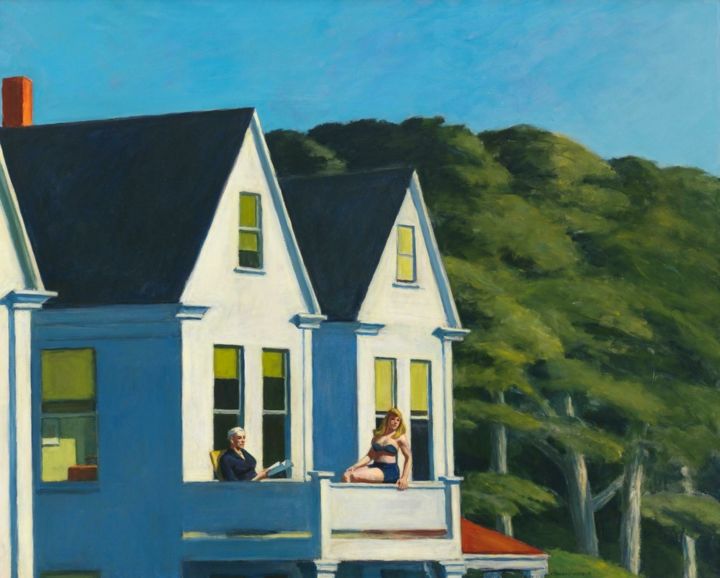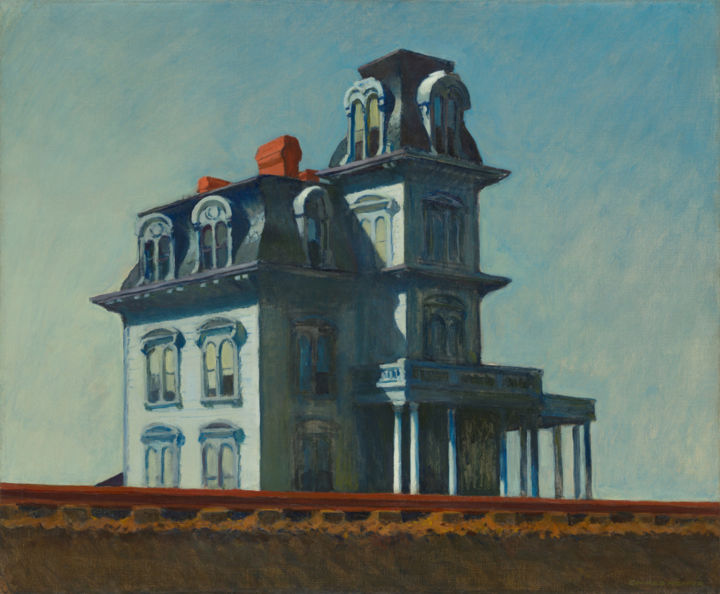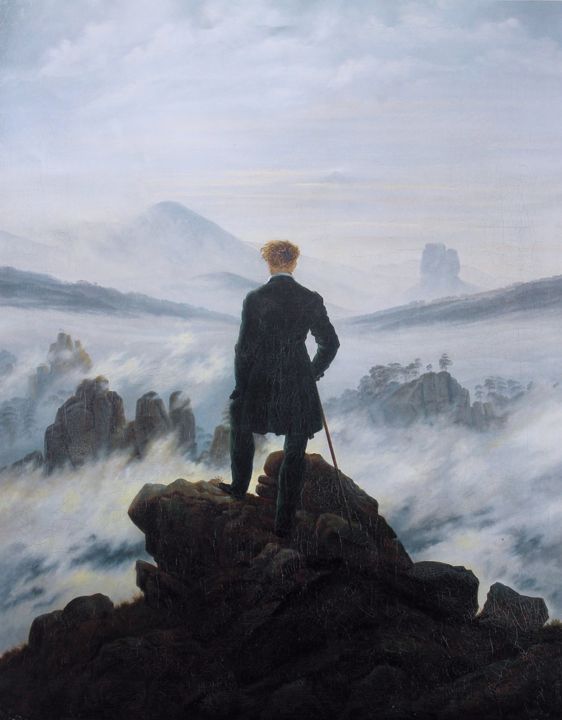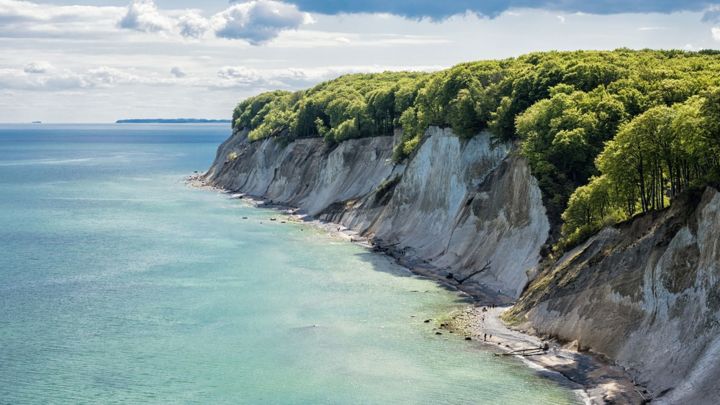1. Claude Monet's Impressionist Normandy
 Claude Monet, Impression, Sunrise, 1872. Musée Marmottan Monet, Paris.
Claude Monet, Impression, Sunrise, 1872. Musée Marmottan Monet, Paris.
Did you know that Normandy and Impressionism are inextricably linked?
Sea breezes and changing weather make this region an Eldorado for any painter in search of more or less intense light variations. The founding artwork of the Impressionist movement (Impression, Sunrise,1872) is a view of Le Havre, the Norman port city where Claude Monet spent a good part of his childhood. Since the region is close to Paris, it quickly became the playground of many artists. Whether they were local, such as Eugène Boudin (born in Honfleur) and Raoul Dufy (born in Le Havre), or whether they lived in the four corners of France, such as Paul Cézanne, Camille Pissarro, Auguste Renoir or Frédéric Bazille, many renowned artists enjoyed the play of light and natural spaces of the Normandy coast. Honfleur, Etretat, Rouen, Giverny are all emblematic symbols of art history.
 Claude Monet, The Cliff of Etretat, Sunrise, 1883. Raleigh, North Carolina Museum of Art.
Claude Monet, The Cliff of Etretat, Sunrise, 1883. Raleigh, North Carolina Museum of Art.
If there were to be only one representative of impressionism in Normandy, it would undoubtedly be Claude Monet. He started his career in Le Havre and then in Rouen and spent the end of his life in the Normandy countryside of Giverny. If you are an admirer of the Waterlily Man, then it's in the region of cider and camembert that you should go. Follow the guide!
3 must-see places to discover Claude Monet's Normandy:
- Monet's house in Giverny, and his famous water lily garden. To visit preferably during the water lily season - from May to September - to apprehend the extent of the work exercised by the artist to tame the aestheticism of nature.

- The streets of the old city, and especially the cathedral of Rouen, depicted over and over again by the artist.

Claude Monet, Rouen Cathedral, West Facade, Sunlight, 1894. National Gallery of Art, Washington.
- The Normandy coast, from Honfleur to Etretat, passing by Le Havre and Sainte-Adresse, to discover the Seine estuary, cradle of Impressionism. Take the opportunity to visit the MuMa, Museum of Modern Art of Le Havre, whose permanent collections and particular architecture are clearly remarkable.
2. Edward Hopper's Deep America
 Edward Hopper, Second Story Sunlight, 1960. Whitney Museum of American Art, New York.
Edward Hopper, Second Story Sunlight, 1960. Whitney Museum of American Art, New York.
If there is one painter who symbolizes the American Way of Life, it's Edward Hopper. Through an anthology of melancholic and solitary artworks depicting a deep and silent America, he has made his place in the pantheon of legendary artists. His artistic production can be divided into two distinct universes: one representing city life and urban landscapes, often nocturnal, having as subjects the typical American diners, bars, offices and gas stations (Nighthawks, Gas, New York Office, Conference at Night, Chop Suey...). The other universe depicts a more rural, wild and natural America, which he often captured in the Cape Cod region, where he owned a second home in which he came to take refuge every summer.
 Edward Hopper, Summer Evening, 1947. Private collection (lucky one!).
Edward Hopper, Summer Evening, 1947. Private collection (lucky one!).
Unless you can go back in time, it will be difficult to immerse yourself in the urban climate of the 1940s in the United States. Fortunately, if the urban landscapes evolve rapidly, the bucolic panoramas of Cape Cod, as for them, remain globally the same. So, for a complete immersion in Hopper's work, here are our tips:
 Edward Hopper, Cape Cod Morning, 1950. Smithsonian American Art Museum, Washington.
Edward Hopper, Cape Cod Morning, 1950. Smithsonian American Art Museum, Washington.
3 must-see places to discover Hopper's melancholic America:
- The bay and the peninsula of Cape Cod, to discover or rediscover the feeling of human insignificance in front of the immensity of nature, characteristic of Hopper's paintings.

- The Whitney Museum of American Art (New York), which presents a large collection of artworks by Edward Hopper, including A Woman in the Sun (1961) and Second Story Sunlight (1960). If you want to see Hopper's most famous artwork, Nighthawks, you'll have to go a little farther afield to the Art Institute of Chicago. You'll also find more of his artworks at the Museum of Modern Art (MoMA) in New York.
 Edward Hopper, Nighthawks, 1942. Art Institute of Chicago.
Edward Hopper, Nighthawks, 1942. Art Institute of Chicago.
- If you have a car, we also recommend a road trip along Route 9W from New York to Poughkeepsie in search of the real Victorian mansion that inspired the masterpiece House by the Railroad, which in turn influenced many filmmakers from the Adams Family to Alfred Hitchcock. If you're interested in this subject, feel free to read our article When Cinema Pays Tribute to the Masterpieces of Art History.
 Edward Hopper, House by the Railroad, 1925. Museum of Modern Art, New York.
Edward Hopper, House by the Railroad, 1925. Museum of Modern Art, New York.
3. The Coastal Germany of Caspar David Friedrich
Although he had a notable influence in landscape painting, Caspar David Friedrich is certainly the most underrated artist in this ranking.
 Caspar David Friedrich, Wanderer above the Sea of Fog, 1818. Kunsthalle Hamburg, Germany.
Caspar David Friedrich, Wanderer above the Sea of Fog, 1818. Kunsthalle Hamburg, Germany.
You may be familiar with his most famous artwork: Wanderer above the Sea of Fog (see illustration). Caspar David Friedrich's landscapes, showing people from the back, contemplating a nature as poetic as indomitable, made him famous all over Europe. His universe, on the border between reality and fantasy, has had many repercussions in our modern society, notably by influencing the world of comic books and video games.
 Caspar David Friedrich, Chalk Cliffs on Rügen, 1818. Kunst Museum Winterthur, Switzerland.
Caspar David Friedrich, Chalk Cliffs on Rügen, 1818. Kunst Museum Winterthur, Switzerland.
Head of the German Romanticism inspired by Goethe's philosophy, his wild landscapes transpire of passionate and introspective emotions. The best thing about mountain and seascape paintings is that they change so little over time. This allows a perfect immersion for those who would like to travel in the footsteps of the artist: the chalk cliffs of the island of Rügen are the same as they were two centuries ago, and the mountain ranges of Central Europe have also not moved an inch.
3 essential places to discover the romantic Germany of Caspar David Friedrich:
- The island of Rügen, the national park of Jasmund and its magnificent chalk cliffs.

- The Kunsthalle of Hamburg, a museum in Northern Germany, which presents in its collections some of the artist's most beautiful masterpieces, including Wanderer above the Sea of Fog (1818) and The Sea of Ice (1824).
 Caspar David Friedrich, The Sea of Ice, 1924. Kunsthalle Hamburg, Germany.
Caspar David Friedrich, The Sea of Ice, 1924. Kunsthalle Hamburg, Germany.
- A walk in the mountains and rocky massifs of Central Europe (Verwall massif, Giant Mountains, Bohemian Switzerland National Park...), to rediscover the feeling of solitude and immensity typical of the universe developed by Friedrich.
 Caspar David Friedrich, The Watzmann, 1824-1825. Alte Nationalgalerie, Berlin.
Caspar David Friedrich, The Watzmann, 1824-1825. Alte Nationalgalerie, Berlin.
4. Edvard Munch's Bucolic Norway
Everyone knows the famous Scream of Munch. However, this isn't the only famous artwork by the Norwegian expressionist painter, as there are no less than 6,000 pieces signed by his hand, not to mention thousands of pages of sketches and preparatory work for his paintings, drawings and watercolors.
 Edvard Munch, The Scream, 1893. Nasjonalgalleriet, Oslo.
Edvard Munch, The Scream, 1893. Nasjonalgalleriet, Oslo.
Through symbolic and delicate artworks, the artist expresses his emotion, alternating between candid joy and tragic melancholy. The landscapes, although simplistic, have a predominant place in his compositions. One can also recognize the originality of the panoramas and weather phenomena typically Nordic. Since it was executed in the land of the Northern Lights and volcanic eruptions, we can better understand the orange and liquefied sky that we discover in the iconic Scream.
 Edvard Munch, Two Human Beings (The Lonely Ones), 1905. Private collection.
Edvard Munch, Two Human Beings (The Lonely Ones), 1905. Private collection.
Whether you're in love with Edvard Munch's style, or you want to visit Norway with a different perspective, we bring you the best places to feel and experience Norwegian expressionism.
 Edvard Munch, Melancholy, 1894-1896, Kunstmuseum Bergen, Norway.
Edvard Munch, Melancholy, 1894-1896, Kunstmuseum Bergen, Norway.
3 must-see places to discover Edvard Munch's bucolic Norway:
- The small village of Åsgårdstrand where Edvard Munch spent many summers and had a very tumultuous sentimental relationship. Here you will discover his old studio house and beautiful views that will take you back to the summer nights depicted in some of the artist's paintings, such as Melancholy, Two Human Beings - The Lonely Ones, or The Young Girls on the Bridge. There's no doubt that you will quickly fall in love with this particular climate, oscillating between wild charm and a sweet feeling of melancholy.
 Edvard Munch's House and Studio in Åsgårdstrand.
Edvard Munch's House and Studio in Åsgårdstrand.
- The Munch Museum (Munch Museet) in Oslo, which has a collection representing more than half of the painter's final works. A must-see if you want to get closer to him.
 Edvard Munch, The Dance of Life, 1899-1900. Nasjonalgalleriet, Oslo.
Edvard Munch, The Dance of Life, 1899-1900. Nasjonalgalleriet, Oslo.
- The National Museum of Oslo (Nasjonalgalleriet, closed until 2022), which also holds an impressive collection of the expressionist artist's masterpieces, including the original Scream.
5. Luminous Provence of Van Gogh
 Vincent Van Gogh, Olive Trees with Yellow Sky and Sun, 1889. Minneapolis Institute of Art.
Vincent Van Gogh, Olive Trees with Yellow Sky and Sun, 1889. Minneapolis Institute of Art.
Although he spent little time in the South of France, this was the artist's most prolific period, producing just over 300 artworks in approximately 15 months. Far from being a simple convalescent stopover, this trip was a real revelation for Van Gogh.
 Vincent Van Gogh, The Siesta (after Millet), 1890. Musée d'Orsay, Paris.
Vincent Van Gogh, The Siesta (after Millet), 1890. Musée d'Orsay, Paris.
No sooner had he set down his suitcases and easel than he fell directly in love with the provençal climate. As a great collector, he was fascinated by the luminosity of Japanese engravings, a sensation he found again in the sunny floral landscapes of the south of France. Fields of lavender, cherry trees in bloom, olive trees everywhere...
Vincent was sure: he was in the right place - "The country (of Provence) seems to me as beautiful as Japan for the limpidity of the atmosphere and the effects of cheerful color." (correspondence with his brother Theo Van Gogh).
 Vincent Van Gogh, Langlois Bridge at Arles with Women Washing, 1888. Kröller-Müller-Museum (Netherlands).
Vincent Van Gogh, Langlois Bridge at Arles with Women Washing, 1888. Kröller-Müller-Museum (Netherlands).
It was in Provence that Vincent Van Gogh realized some of his most famous masterpieces: The Starry Night(s), The Sunflowers, Café Terrace at Night, The Night Café, Van Gogh's room in Arles, the various portraits of the Roulin family or even The Siesta and The First Steps (after Millet). For an artistic stroll under the southern sun, follow the guide:
2 must-see places to discover Van Gogh's idyllic Provence:
- The city of Arles, and in particular the Café Van Gogh (place du Forum), walk along the Rhone quay to admire the place of creation of the painting Starry Night Over the Rhône. Off the beaten track, many other places will take you on a journey through the paintings of the great Dutch master: the Trinquetaille bridge, the Langlois bridge (renamed Van Gogh bridge), the old mill (rue Mireille), the yellow house (place Lamartine), the public garden, the arenas, the "Alyscamps"... To facilitate your visit, you will find a pedestrian circuit "on the footsteps of Van Gogh". Don't hesitate to visit the Van Gogh Foundation, which, although it doesn't have any of the master's artworks, does a real mediation work by confronting contemporary creation with influence of the Dutch painter.
 On the left, Starry Night Over the Rhône (1888, Musée d'Orsay). On the right, the Rhone quay in Arles.
On the left, Starry Night Over the Rhône (1888, Musée d'Orsay). On the right, the Rhone quay in Arles.
- The village of Saint Rémy de Provence, 40 minutes from Arles, where Van Gogh was interned for a few months, from 1889 to 1890. In the Saint Paul de Mausole asylum (part of which has been transformed into a sanctuary in memory of the artist), he created more than 150 artworks, including one of the most famous: The Starry Night (which is today among the masterpieces of the MoMA collection in New York). There, you can also take advantage of a marked out itinerary crossing this typically Provencal village and discover numerous reproductions of his artwork placed along your stroll.
 Vincent Van Gogh, The Starry Night, 1889. Museum of Modern Art, New York.
Vincent Van Gogh, The Starry Night, 1889. Museum of Modern Art, New York.
So, when are we leaving?


 Bastien Alleaume (Crapsule Project)
Bastien Alleaume (Crapsule Project)